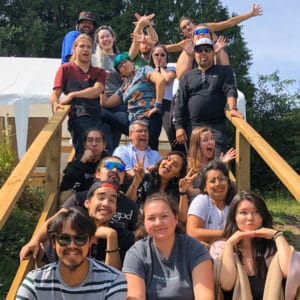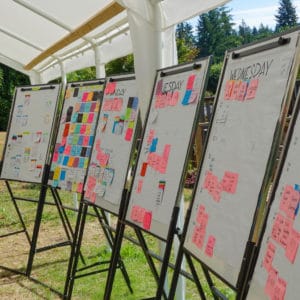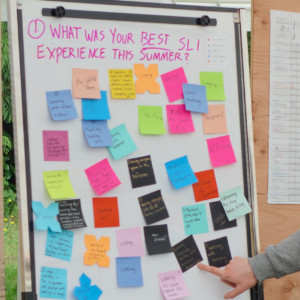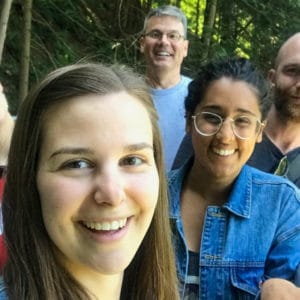
This past week, I was lucky to have the opportunity to fly up to Alaska and meet the community with which Will and I will be working over the summer. Throughout the flurry of introductions, everyone was incredibly kind and welcoming. I was struck by the palpable energy and enthusiasm of both the language learners and the elders; it was inspiring to see so many people contributing their creativity and personal time to the various revitalization efforts.

I spent most of my time running through existing rides with Alisha, Candace and Michael, then hunting more Alutiiq and helping invent and streamline more rides. It was fun getting the hang of collaborative ride-making, which is something of a new skill for me– I’m usually so impatient that I just hunt one thing after another in quick succession, then forget large swathes of it. It was definitely good for me to learn to apply the brakes and teach off what I had learned to someone else. In the process, I learned a bit of Alutiiq, and became quite enamored of its beautiful sound and structure. The most challenging part of this process was not leaning too heavily on my linguistics training. Because I’m studying linguistics at Stanford, it’s really tempting for me to analyze every element of the language as I encounter it– or worse, to look each pattern up in a reference grammar in order to confirm that it works how I suspect it does, which is essentially akin to googling the answers to a half-finished crossword puzzle. I have to remind myself that I’m not here on a linguistic research project per se, but on a quest to find the easiest, most intuitive way of learning and teaching the language. Realistically, the middle school and high school students who will be learning Alutiiq will not have any background in linguistics. Nor should they need to– if all the set-ups are obvious enough, learning the language should be so natural that they understand each piece of grammar simply from context, usage and its relation to other patterns within Alutiiq. To tailor the rides for this audience, I have to relinquish some of my attachment to linguistic terminology and think of the language from an internal perspective.
Discussing this challenge with Evan led us to coin a new technique: TQ “Nowhere Man”. For anyone who has seen the animated movie The Yellow Submarine, remember the part where the little nowhere man is spinning around in little circles writing footnotes for his umptieth paper while the Beatles are singing to him, cajoling him to get involved with the world?
He’s a real nowhere man/Sitting in his nowhere land/Making all his nowhere plans for nobody
Nowhere man, please listen/You don’t know what you’re missing/Nowhere man, the world is at your command…
The main point of this technique is that however you process the language, it is crucial to be able to engage and communicate with other learners in a revitalization setting. It’s all well and good for me to sit on a couch muttering to myself, “Split ergativity? Intransitive– unergative? Or antipassive…”, but that’s not really helping anyone else. If instead I can find a way to set up and prove what I’m hypothesizing, it will not only aid others who are trying to get a handle on the language, but it may also clarify my own thinking and prevent me from leaping to conclusions. To summarize TQ “Nowhere man”: Be sure you’re not so caught up in your own head that you miss the rockstars around you.
Another new thought that came out of this past week was the idea of experimental techniques for teaching younger kids to language hunt. Evan and I were wondering whether middle school-age students could get the hang of hunting, and if so, how it would be best to introduce it in a fun, approachable way. I personally love hunting, as everyone I bothered this last week will be able to attest. It makes me deeply happy to elicit new pieces of Alutiiq using dramatic facial expressions and funny scenarios, then jigsaw them together into my evolving understanding of the language. But how to convey that same hunger for language to young learners? My instinct is to make it as much of a game as possible. With that in mind, I suggested to Evan that we might start from a modified version of charades, with the following simple rules:
1. No English.
2. Superpowers: the Hunter gets to tell the Huntee to….
- Rewind (go back in the conversation so the Hunter can get a word or pattern that went by too fast, or alter the game in a new way)
- Slow Down
- Speed Up
Each superpower may be signaled with a handsign, optionally accompanied with a funny sound effect.
We could introduce the game, get everyone comfortable with it, then encourage them to play it in any language in their free time– Spanish, Tagalog, anything they want. The middle schoolers could then hunt Alutiiq in any number of settings, from an after-school Girls’ Club with Candace to partner tutoring with high school students to gatherings with elders. By the time they are enrolled in an Alutiiq language class, they will already have the skillset to elicit the language they need, and they will be in the proactive, engaged mindset of advocating for their own learning. I’m truly excited to test this idea and others this summer as I work with Will to support the Alutiiq learners and teachers in the revitalization process. For several years, it has been my dream to work in language revitalization; I could not ask for a more friendly, dynamic and intelligent learning community with whom to embark on this dream. I learned so much from everyone in the past week alone, and I can only imagine how much more I will learn and grow in the course of this ten-week adventure. So, to all the Alutiiq learners and teachers (and especially to Alisha and the rest of my host family)– Quyanaasinaq!




